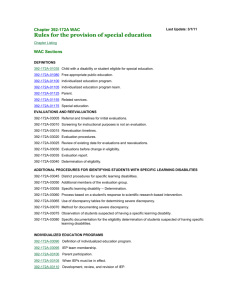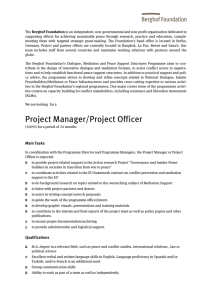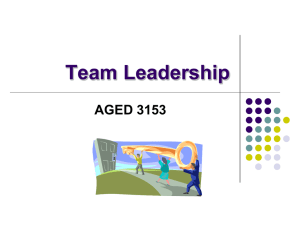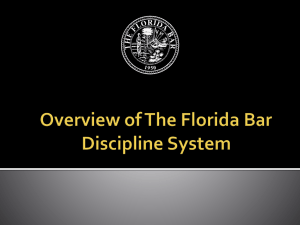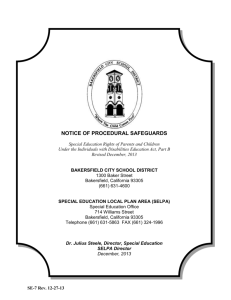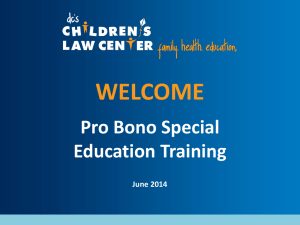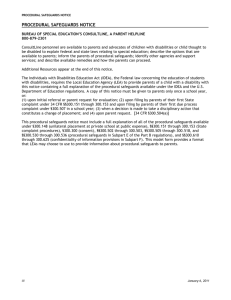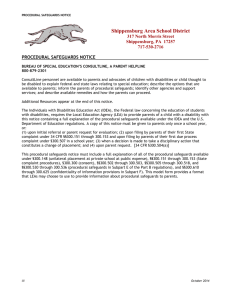Individuals with Disabilities Act 40 USC §1400 et
advertisement
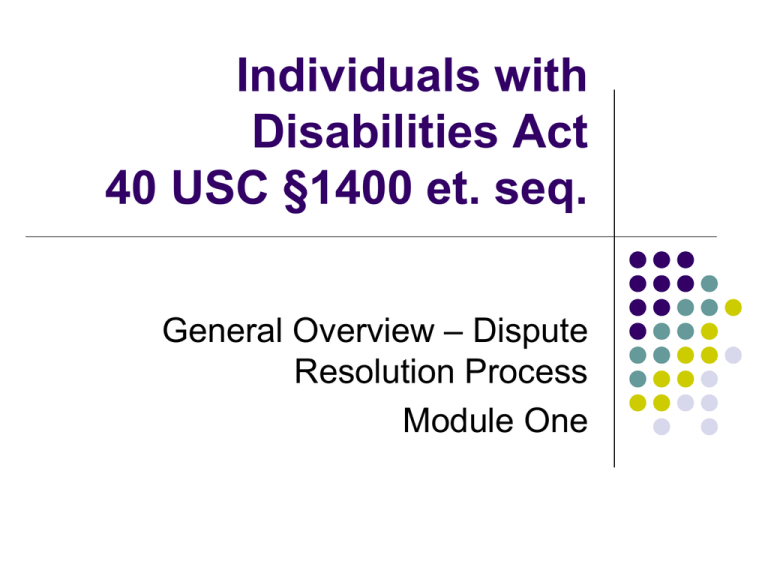
Individuals with Disabilities Act 40 USC §1400 et. seq. General Overview – Dispute Resolution Process Module One Where you can find the law? Individuals with Disabilities Education Act (IDEA) Statute: 20 U.S.C. §1400 et. seq. Regulations: 34 C.F.R. Part 300 Supreme Court Cases 10th Circuit State and Federal District Courts What law relates to the IDEA? Section 504 of the Rehabilitation Act of 1973 No Child Left Behind Act of 2001 Family Educational Rights and Privacy Act McKinney-Vento Homeless Assistance Act Statute 20 U.S.C §1400 et. seq. Act divided into five parts: 1. Part A – General Provisions 1400 – Findings and Purposes 1401 - Definitions 2. Part B – Ages 3-21 3. Part C – Birth to 3 (Sooner Start) 4. Part D – National Activities to Improve Education of Children with Disabilities 5. Part E – National Center for Special Education Research IDEA - Part B When a state accepts federal financial aid, each LEA must make available FAPE in the LRE to qualifying disabled children. Who is an LEA? Who qualifies as a disabled child under the IDEA? What is FAPE? How is FAPE determined? How is FAPE provided? What is the LRE? IDEA – Part B An LEA is the local educational agency. Who qualifies as a child with a disability under the IDEA? A child with mental retardation, hearing impairments, speech or language impairments, visual impairments, emotional disturbance, orthopedic impairments, autism, traumatic brain injury, other health impairments, or specific learning disabilities and who, by reason thereof, needs special education and related services. FAPE is a Free and Appropriate Public Education. FAPE determined by statute, regulation and case law. 20 USC1401 (9) 34 CFR 300.101, 300.17 Board of Education v. Rowley, 458 U.S. 176 (1982). FAPE is provided in accordance with the IEP. Schools are required to educate children with disabilities with children who are not disabled to the maximum extent appropriate. A child may only be removed from the regular setting if the nature or severity of the disability is such that the child cannot be educated in regular classes, even with the use of supplementary aids and services. 20 USC§1412. Disputes - Examples Identification –child find Evaluation – eligibility, determine individual needs to formulate the IEP, evaluation tools, qualification of tester, IEE Educational Placement – LRE, continuum of service Provision of FAPE – failure to provide IEP services; development of the IEP, failure to follow the law (discipline). Avenues of Dispute Resolution Opportunity for Mediation over dispute between parent / school Informal Complaint to the SDE Formal Complaint to the SD Opportunity for Mediation Formal Complaint to the LEA Opportunity for Mediation Opportunity for Mediation Due Process Complaint Notice Opportunity for Mediation Mandatory 30 day Resolution Time Period Resolution Session Convened within 15 days Unless waived by both parties in writing Attended by persons who are chosen by the parties – who have facts about the DP notice. To discuss issues of the DP notice Any agreement drafted in a legally enforceable Resolution Agreement. Resolution Session States must maintain or increase the number of resolution agreements coming out of resolution sessions. We can bring the proverbial horses to water – but how do you get them to drink? Innovative Programs – Third-party Neutral Facilitators! Will you be the rock that redirects the course of the river? -- Claire Nuer. Due Process 34 CFR §300.507-10 Parent or Public Agency may file on any issue related to: Identification Evaluation Educational Placement Provision of FAPE Complaint must allege a violation that occurred no more than 2 years before filer knew or should have known about the problem. Deemed sufficient unless the receiving party objects to sufficiency within 15 days of receiving complaint. (File an objection) HO decides within 5 days. May give party the opportunity to amend. Content: Name of child Address of the residence Name of the school or contact info if child is homeless Description of the nature of the problem, including facts Proposed resolution to the extent known Due Process Timelines First 30 days are a mandatory resolution time period (may be shortened) If a party amends the complaint, 30 day time period starts all over again! After the 30 days, or other qualifying event, the due process complaint notice springs to life. Once live, the due process must be heard and a decision rendered within 45 days, unless properly extended by the parties. What happens in the first 30 days of Due Process? ALOT! Parties are often confused by all the activity. SERC assigns the case to an impartial officer. SERC asks if the parties want a neutral facilitator for the RS. Within 7 days, Officer contacts parties to arrange a pre-hearing conference (scheduling) Within 10 days, School district must file an response to each and every allegation. Within 15 days, parties must schedule a resolution session. Parties may waive the RS, in writing, or opt for mediation. Due Process Filed Day 1 SERC sets case for hearing and assigns HO Within 3-4 days SERC contacts parties to inquire if the parties desire a 3rd party neutral facilitator Contact within 7 days HO contacts the parties set up a pre-hearing (scheduling conference) Contact within 7 days School must respond to the DPH Complaint Notice By the 10th day School must schedule a resolution session (parties may opt for mediation or waive the meeting in writing) By the 15th day Resolution session / mediation As the parties can meet. HO conducts 2nd pre-hearing conference (prepare for hearing) Date determined in 1st conference, towards the end of the 30 days time period. Resolution Time (30 days) Hearing Time (45 days) Begins at: * End of 30 day resolution time. * Immediately, if both parties waive the resolution session in writing. * Immediately, if both parties agree in writing that no agreement is possible, after mediation or resolution session. * Immediately, if both parties agree in writing to continue mediation within the 30 day resolution period, but later one party withdraws from the process. Hearing Decision Due within 20 days of submission by the last party or as agreed by the parties. Resolution Sessions 34 CFR 300.510 Within 15 days of receiving complaint, the LEA must convene a resolution meeting. Who must attend? Parents Relevant members of the IEP team who have specific knowledge of the facts identified in the complaint. LEA must include a representative that has decision making authority on behalf of the agency LEA may not bring an attorney if the parent does not bring an attorney. What is the purpose of the meeting? To discuss the due process complaint and the facts that form the basis of the complaint – so the LEA has opportunity to resolve the dispute. RS not required when parties waive or opt out to mediation Individuals with Disabilities Education Act Expedited - Due Process Time Chart Due Process Filed Begins on the day of filing – with the resolution time period contained within the hearing time. SERC sets case for hearing and assigns HO ASAP SERC contacts parties to inquire if the parties desire a 3rd party neutral facilitator ASAP HO contacts the parties set up a pre-hearing (scheduling conference and to prepare for hearing) ASAP after assignment Hearing Time (30 days) No extensions Resolution Time (15 days within the 30 day hearing time) Expedited 34 CFR §§300.530 -300531 No response or sufficiency objection is required. School must schedule a resolution session (parties may opt for mediation or waive the meeting in writing) By the 7th day Resolution session / mediation By the 7th day Hearing Occurs within 20 school days from filing. Decision Due within 10 school days of the hearing. If issue is not resolved: Resolution Sessions 34 CFR 300.510 If the LEA has not resolved the issue to the satisfaction of the parent, they go to hearing. What happens if a party refuses to participate in RS? What happens if parties agree on a resolution? What adjustments can occur in the 30 day resolution period? What Is Expected of the Facilitator for Resolution Sessions? Promptly contact the parties after assignment of a case. Work with the parties to arrange the RS as quickly as possible. Seek assistance of SERC if any issues arise (example: scheduling, technical assistance). I suppose leadership at one time meant muscles… …today it means getting along with people. --Indira Gandhi. Resolution Sessions 34 CFR 300.510 If the LEA has not resolved the issue to the satisfaction of the parent, they go to hearing. What happens if a party refuses to participate in RS? What happens if parties agree on a resolution? Except where the parties have jointly agreed to waive the resolution period, failure of parent to participate in the resolution meeting will delays the timelines for the resolution process and the hearing until the meeting is held. If parent refuses, School may ask that DPH be canceled. If school refuses, the parent may ask to proceed to hearing. Resolution Agreement. What adjustments can occur in the 30 day resolution period? The hearing timeline (45 days) starts the day after one of the following events: Both parties waive the resolution session in writing. After mediation or resolution session, both parties agree in writing that no agreement is possible. Both parties agree in writing to continue mediation at the end of the 30 day resolution period, but later one party withdraws from the mediation process. Resolution Agreement 34 CFR §300.510(d) If a resolution to the dispute is reached at the resolution meeting, the parties must execute a legally binding agreement that is: Signed by both the parent and a representative of the agency who has authority to bind the district; and Enforceable in any state court or competent jurisdiction or in a district court of the United States. Discussion What if parties agree to some issues but not all? Resolution Agreement is written to all issues resolved. Remaining issues move to hearing. Sample Resolution Agreement Sample Agreement is a suggested format. Important to contain closing provisions that explain to a pro se parent/ school some of the requirements. Experience suggests that a great deal of time is spent on crafting the specific agreement. Center maintains a computer and printer if the facilitator needs to check it out.
